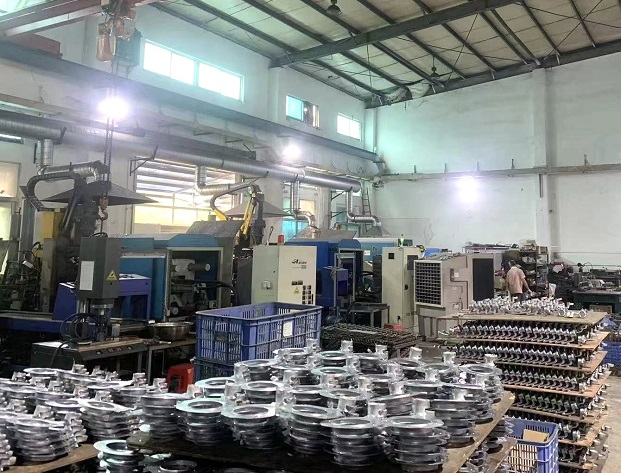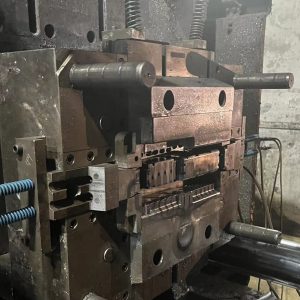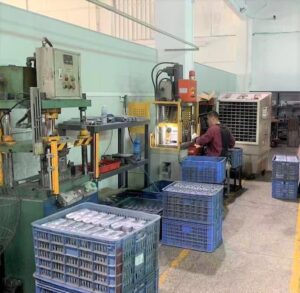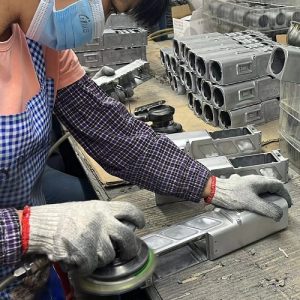When developing an aluminum product, the manufacturing process that you’ll utilize must be taken into account in a comprehensive manner. Aluminum can be formed using a variety of techniques, but aluminum die casting is one of the most common choices for designers to move forward with.
Aluminum alloy is well known for its lightweight, durable, malleable and corrosion-resistant, as well as high dimensional stability. Therefore, aluminum die casting is the preferred manufacturing process for many automotive, industrial, consumer and medical applications. Additionally, it’s frequently used to make lighting, hydraulic, and electrical components.
If you want to learn more about the die-cast aluminum process and need to determine whether it is the best option for your application, you’ve come to the right place. This article will provide you an overview of multiple aspects for aluminum die casting and some guidelines how to make full use of it.

What is Aluminum Die Casting?
Aluminum die casting is a manufacturing process that uses reusable molds or dies to create aluminum parts with precise dimensions, sharply defined edges, smooth or texture surfaces. The aluminum casting dies produced by hardened tool steel consists of at least two halves separated to allow castings to be removed. The dies would be securely mounted in die casting machine, while one of the two halves is stationary and the other is movable. Depending on the complexity of part design, aluminum casting dies can be simple or very complex, with or without moveable cores, sliders or other inserts. Tens of thousands of aluminum castings may be supplied quickly using the aluminum die casting process.

Aluminum die casting is an automated casting process that liquid aluminum alloy is forced into a mold under intense pressure at a high speed to generate metal parts with desirable shape. The aluminum alloys are being heated and injected into the dies through a die casting machine. It is a technique to heat up aluminum alloys at a high temperature till they are molten in the cold chamber of the casting machine, otherwise, the molten aluminum would harm the machine if the injection mechanism is submerged as in the hot chamber process. The material would retain the inside cavity’s shape of the mold during the cooling process, and then the part can be taken out supporting with the ejection system. It is common to see parts made of aluminum have precisely shaped and smooth surfaces, while the finished products don’t need minimal machining to allow the parts moving into the delivery stage quickly. Furthermore, a die casting mold may be recycled and repeated to manufacture thousands of the same part before it deteriorates. Obviously, aluminum die casting is an ideal manufacturing solution for metal parts in mass productions at competitive price, and that’s why Aluminum die casting has been playing increasing important role in various industry applications.
Common Aluminum Die Casting Alloys
Aluminum ranks the third for the most common element on earth, when oxygen and silicon being the first and second place respectively. Aluminum extraction from the earth’s crust is challenging since it requires more complicated processes than the extraction of iron or other metals. Aluminum is often alloyed with other metals (include zinc, magnesium, copper, etc) to improve both its own properties and the properties of the metals that are alloyed, even though it is processed as pure aluminum.
There are many different kinds of aluminum alloys available, but only a handful of them are suitable to use in die casting, such as A360, A380, A383, A413 and B390. In comparison to the qualities of raw aluminum, each of these alloys has somewhat different features that have been briefly covered below.
| Characteristics of Aluminum Alloys | |||
|---|---|---|---|
| Material | Tensile Strength (Mpa) | Thermal Conductivity (W/mK) | Features |
| Aluminum A360 | 317 | 113 |
|
| Aluminum A380 | 325 | 96 |
|
| Aluminum A383
(ADC12) |
310 | 96 |
|
| Aluminum A413 | 295 | 121 |
|
| Aluminum B390 | 317 | 134 |
|

The composition of alloying elements varies among various aluminum alloys. The following comparison chart illustrates the ratio of alloying elements found in each type of aluminum alloy.
| Composition of Aluminum Alloys | |||||
|---|---|---|---|---|---|
| Element/ Ratio/ Alloy | A360 | A380 | A383 | A413 | B390 |
| Aluminum | Primary | Primary | Primary | Primary | Primary |
| Magnesium | 0.35 – 0.50 | 0.1 | 0.1 | 2.0 | 0.45-0.65 |
| Iron (max) | 0.8 – 1.0 | 1.3 | 1.3 | 2.0 | 1.3 |
| Zinc | 0.20 | 3.0 | 3.0 | 0.5 | 1.5 |
| Silicon | 9.0 – 11.5 | 7.5-9.5 | 9.5-11.5 | 11.0-13.0 | 16.0-18.0 |
| Copper | 0.05 – 0.08 | 3.0-4.0 | 2.0-3.0 | 1.0 | 4.0-5.0 |
| Tin (max) | 0.03 | 0.35 | 0.15 | 0.15 | – |
| Nickel (max) | 0.03 | 0.5 | 0.3 | 0.5 | 0.1 |
| Manganese | 0.50 – 0.60 | 0.5 | 0.5 | 0.35 | 0.5 |
| Others | – | 0.5 | 0.5 | 0.25 | 0.2 |
Machine for Aluminum Die Casting
There are two different types of die casting machine that are cold chamber and hot chamber die casting machine. The difference between them lies in the method used to inject the molten metal into the mold. In cold die casting, the melting pot is not connected to the die casting system. Instead, the molten melt is ladled into the cold chamber and driven into the mold by a plunger. In hot chamber die casting, a plunger is used to pump molten metal through a gooseneck and into the mold. The hot chamber is attached to the melting pot. Below is an image showing hot chamber die casting on the left and cold chamber die casting on the right.
The hot chamber die casting machine is well known for the high production efficiency and automation level. However, it’s not frequently utilized in die casting aluminum for the reason that the heat needed to melt the aluminum alloys at high melting point can’t be completely afforded by the machine’s furnace. Any attempt to use the hot chamber die casting for aluminum alloy could result in damage to the furnace or machine components.
The most popular and favored machine for aluminum die casting is cold chamber die casting machine, which can easily create denser metal castings at a go. The cold chamber die casting machine has a good demand of the die cast products like integral fastening components. Additionally, compared to many other mass-production techniques, it supports complicated shapes within tighter tolerances. The die-cast components manufactured by cold chamber die casting machine have improved mechanical qualities, thinner wall thickness and stronger structure.

Over the past few decades, the aluminum die casting industries has experienced significant growth. Modern technology has enabled manufacturers to dramatically reduce production costs while maintaining high quality for the die casted parts. As a result, manufacturers of die casting machines compete with one another to provide us with more advanced and effective technologies. Among the leading manufacturers of die casting equipments, here are some of the top brands for your reference.
- LK
- Yizumi
- Bühler
- Toshiba
- UBE
- Frech
- Kurtz Ersa
- Idra, etc.
Process of Aluminum Die Casting
For the ease of understanding, we have classified the Aluminum die casting process into the following 5 steps.
- Mold Preparation
The mold or die needs to be completely cleaned and lubricated before each casting cycle. First, use a sprayer mechanism to thoroughly clean the die halves to get rid of any leftover from the previous production. During the casting process, never forget to spray lubricant onto the die to get it ready for the subsequent cycle.
- Injection
The molten aluminum is stored in a furnace located outside the cold chamber equipment. When the die casting process starts, the molten aluminum is poured into the shot chamber and then injected into the die cavity with the aid of a plunger, which is powered by a hydraulic cylinder.
- Solidification
After filling up the mold cavity with molten aluminum alloy, leave it to cool off for a specific time. The casting will gradually solidify and retain the shape of the mold’s cavity.
- Ejection
Once the casting part becomes hardened, it is time to separate the die halves through the die casting machine. The part will then be ejected from the moving die half with an ejection mechanism.
- Trimming & Machining
To remove the excess material using a trim die is one essential step for the raw casting part. It is also often to be machined to achieve additional features that were challenging to form directly from casting.
The Advantages of Aluminum Die Casting
In comparison to other metal-forming techniques, aluminum die casting has a number of benefits that may lead it the most reliable and efficient techniques for manufacturing your aluminum parts.
- Lightweight
The lightweight nature of aluminum is well recognized when compared to other metals. Comparing to iron or zinc, an average aluminum alloy is almost three times lighter. Aluminum is not as strong as iron or zinc, but it has a better strength-to-weight ratio, which makes it the perfect option for applications where weight is a key consideration.
- Versatility
Almost any size, shape or form imaginable can be created using aluminum die casting. It creates every part to the design specifications flawlessly, from the smallest electrical component weighing less than a gram to gearbox casings and clutch housings for automobiles. Engineers can benefit from the remarkable characteristics related to aluminum die casting to custom make metal parts thanks to the wide range of design flexibility, no matter how unique or unusual, and have it become a reality.
- Durability
In contrast with most other alloys, aluminum castings have a strong corrosion and wear resistance, because the surface of aluminum castings oxidizes when they are exposed to air, which is a property of the metal. The longevity and reliability of aluminum castings results from this unique feature, so aluminum alloy parts can be used without risk in adverse environments. What’s more, a variety of surface treatments are available that can further improve its durability. Users are happy to gain great values from its extended lifetime.
- Effectiveness
Producers are always striving for faster and more effective ways to produce goods of a high caliber. As the demand for increased efficiency and performance develops, Aluminum die casting has proved more than capable of meeting and beyond what has been required, to provide goods on time and to fulfill the satisfaction of customers.
Compared to other manufacturing techniques, aluminum die casting has grown as the most widely used manufacturing process for large quantity of metal components worldwide.
- Cost
Every industry is constantly looking for ways to save costs while still producing high-quality products. The possibility of low cost for part manufacturing is one of the main reasons why companies choose the aluminum die casting. A large portion of the cost reductions is attributed to the lower cost of materials, production cycle time and the lack of finishing requirements for finished products. Additionally, customers and consumers benefit from the lightweight, versatility, durability and etc, all of which make aluminum die casting a cost-effective alternative to other manufacturing technologies.
Industries Served By Aluminum Die Casting
- Automotive
Automakers are constantly looking for ways to incorporate high strength aluminum castings in their product designs, as the pressure to increase vehicle’s fuel efficiency is growing rapidly. Aluminum die casting manufacturers have been refining and enhancing their techniques to speed up production output and improve product quality at a competitive price.
OIL PUMPS, WATER PUMP HOUSINGS, CONNECTOR, TRANSMISSION PARTS, AND A WIDE VARIETY OF BRACKETS are just a few of the aluminum cast components that have become designed and made for automotive industry , due to their properties of great durability and reliability.
- Electronic
With the fast development in consumer product market, aluminum die cast products have drawn more and more interest from the electronics industry, where the most exciting features are the light weight and heat transfer capabilities. Aluminum die casting is widely used to create the cover, enclosure and heat sink for a variety of electronics products, including but not limit to cell phones, appliances, televisions, laptops, and so on.
Aluminum die cast parts is usually designed to take heat away from built-in components of electronic products when performing. They are casted with the possibility to eliminate secondary operations such as machining and assembly, which reduces production costs and speed up the manufacturing. Additionally, aluminum parts are electrically conductive, which means they can be grounded without an issue.
- Lighting
Aluminum die casting products are in huge demand for the lighting industry. Aluminum is the perfect material for light and lamp parts because to its lightweight, corrosion resistance and excellent thermal conductivity, and the finished die cast lighting parts have excellent dimensional accuracy with less or no machining. Lighting parts made from aluminum alloy die casting are ideal for both indoor and outdoor use because they naturally generate a protective thin oxide coating that shields the surfaces from corrosion.
The excellent thermal conductivity of lighting parts made of aluminum alloy, which is three times greater than that of cast steel, is a key factor in lighting manufacturers’ decision to choose aluminum die casting as both cooling and heating solutions, such as heat sinks, covers and shades for LED lights and lamps applications.
For lighting parts, both gravity casting and die casting are practical to produce and have their benefits. Gravity casting has a low initial mold cost, so producing lighting parts in small quantities might be more profitable. Die casting, however, is the better option if the structure is complicated and there are high requirements of dimensional precision and surface finish.
- Healthcare
There is a considerable need for complex parts with great accuracy in the healthcare industry. Aluminum die casting is used to manufacture enclosure, housing and interior parts for various medical devices, including dialysis equipment, ultrasound systems, hospital beds, monitoring devices, etc. The healthcare industry has a particularly high expectation for parts with an excellent strength-to-weight ratio, as the lighter the parts the more convenient to use the equipments.
Aluminum cast enclosure is capable of housing sensitive electronics in most of conditions. Aluminum’s natural property of shielding against radio frequency interference (RFI) and electromagnetic interference (EMI) makes it a great choice for die casting aluminum enclosures. Aluminum casting’s seamless construction produces a sealed, watertight container that can endure any type of circumstance.
- Aerospace
The aerospace industry requires an alloy that is lightweight and impact resistant, just like the automotive industry. In addition, custom complex tools and strong structural components are frequently required by aerospace industry. As a result, numerous sections of an airplane are made up with aluminum die casting parts, which is approximately 80% of the structure.
Die-cast aluminum alloy is used to make a number of aerospace components, including the piston heads for aircraft engines, housings for loading cargo, fuel system components, housings for distributor caps, lighting fixture components, and detention rings for electronic enclosures. Die casting aluminum parts have the properties and characteristics that the aerospace industry requires, which allows aircraft manufacturers to achieve a significant saving through the application.
Design Highlights for Aluminum Die Casting
- Parting line
A parting line is used to divide the mold into two halves. There are parting lines on every parts that they cannot be avoided. When designing an aluminum die cast part, keep in mind that the melt will always flow toward the parting line since it is where the displaced air can escape or vent most easily. The border between the internal and external sections is defined by the parting line that needs to be set correctly, and the location where it will go must be addressed and approved before the beginning of steel cutting for die casting mold.
- Gate Position
The part designer and the manufacturer are supposed to collaboratively consider where the gate position should be. In order to improve the overall quality of the aluminum die-cast product, it should also be placed to allow seamless flow of metals. If there is a chance that the molten aluminum will cool before getting into every corner of the die, the gate position may be relocated, or sometimes one injection point or more may be added to resolve the issue.
- Draft angle
The term “draft angle” describes the slight taper that surrounds the mold’s sides, which facilitates the part releasing from the mold cavity. It’s critical to incorporate the draft angle in all parallel surfaces of the die, so as to finish a smooth and complete die casting process. The amount of draft angle required counts on the design following the general rules that a greater draft angle is for inside holes and walls while a smaller draft angle for exterior walls.

- Wall thickness
When designing a wall, avoid making it thin or weak-looking. Make sure the wall is thick enough, because a thin wall would slow down the molten metal’s free flow. The worst case can be that the metal stars to solidify when the mold is not yet completely filled. The wall shouldn’t be too thick, though, as this could waste resources and prolong the production cycle time. One more important thing, it would be wise to opt for a uniform wall thickness throughout the part for better results.
- Sharp edge
In aluminum die casting, it’s best to avoid sharp edges because they eventually weaken the strength of the casted parts. Make curved intersections, including the fillets and the radius, where two surfaces with sharp edges meet. The curved junction in the internal edges of the part is called a fillet, while the curved junction in the exterior edges is called a radius. These rounded edges help a lot for the metal injection of aluminum parts.
- Others
For aluminum parts in large quantity demand, the die casting mold is expected to run and last to the maximum. Secondary processing such as Heat treatment and die coatings are the most promising and economical techniques to improve the durability of aluminum casting mold. By doing so, it can resist thermal fatigue very effectively and prolong the life cycle.
Aluminum Die Casting Service @GEMS-MFG
GEMS-MFG uses the advanced manufacturing processes following lean manufacturing concepts to bring your products into market better, quicker and smarter. We assist you in realizing your vision, from new product design to high-level finished assembly. We are recognized for operational excellence and high product quality by customers among multiple industries. Throughout the product lifecycle, we never stop striving to increase efficiency, responsiveness, and decision accuracy.
- Material options and applications
With the natural properties of metal, parts produced by die casting are stronger, more rigid and have a longer life period than parts made by other processes like 3D printing and injection molding. When it comes to material choices and considerations, GEMS team will gladly discuss your specific application and assist you in determining whether die casting is the best casting process for you. And, if that’s the case, which method of die casting will supply you with the best result.
- Dimensional accuracy and tight tolerance
When you cast a part, you can achieve complex net shapes with variable wall thicknesses and tight tolerance, including external threads and internal features with minimal draft angle that reduce secondary operations to the minimum. CNC machining is also often applied to high dimensional accuracy for instances where a part is crucial to performance and functionality.
- Complex part design with integrated features
Die casting operations accept complex shapes and geometries that you can combine multiple parts into a single part, eliminating assembly operations and lowering labor costs, with the added benefits of simplified stock control and greater component consistency.
- Efficiency and repeatability
Once the die has been created, you can cast it over and over again, allowing you to easily build hundreds of thousands or even millions of identical individual parts. Die casting is also preferred because of its precision and repeatability, which are critical for many metal items to fulfill mass production demands.
- Varied surface finishes
Whilst it’s not always required, the surface finishing for die casting components can be tailored in a variety of options to improve part functioning and product needs, allowing you to finish your piece to your exact specifications. It might include anything from adding a decorative touch to improving chemical resistance, and it’s the last stage in making sure your finished product exceeds expectations.
- Reliable, high-performance assembly capabilities
We offer assemblies of Die Casting parts with or without plastic, electronic component and more, so you don’t have to juggle multiple vendors’ managements, suffering from various timelines and thousands of moving parts. We aim to simplify the supply chain and increase your profitability.
Conclusion
To sum up, the metal-forming approach you select will ultimately depend on your budget, the intended use of your aluminum part, and the quantity of parts you plan to produce. Die casting is a costly process when thinking about the huge amount of tooling investment, but if you need an aluminum part with complex design and a huge demand for the long run, it’s definitely worthwhile for your efforts.
We really hope that this article being an overview to aluminum die casting was able to provide you with accurate information and insight understanding. However, we have only presented a few of the key aspects for aluminum die casting here. If you wish to know more about aluminum die casting, we recommend you to send us a message. Also, if you are interested to discuss your project about metal parts, please contact our cus





